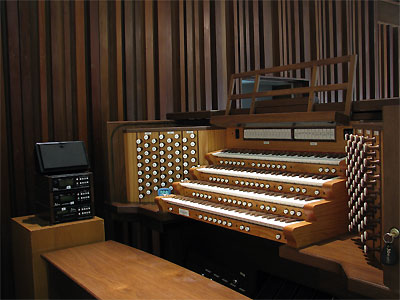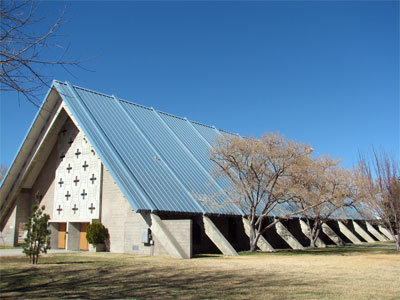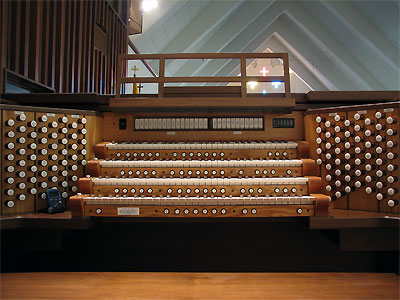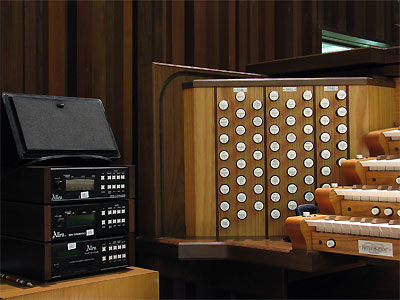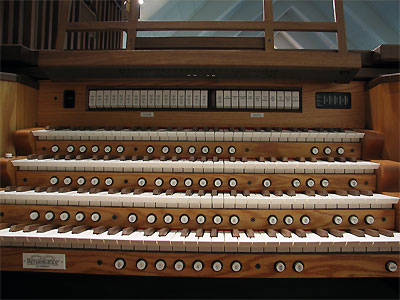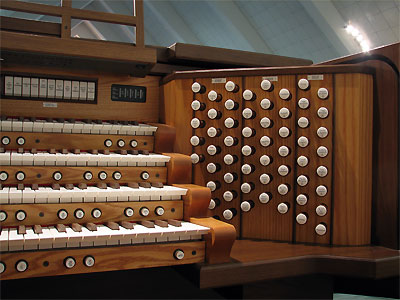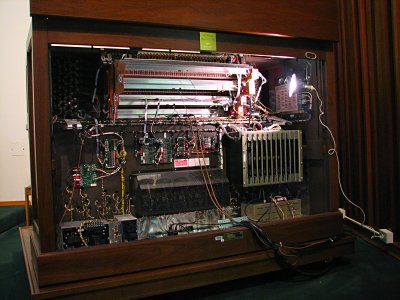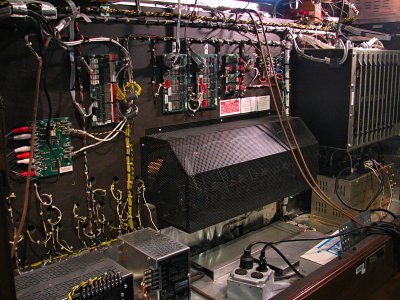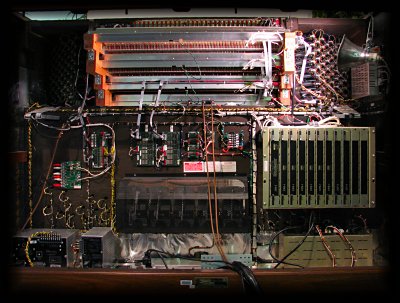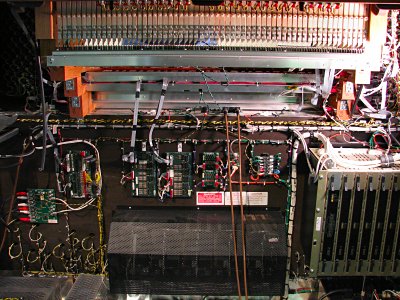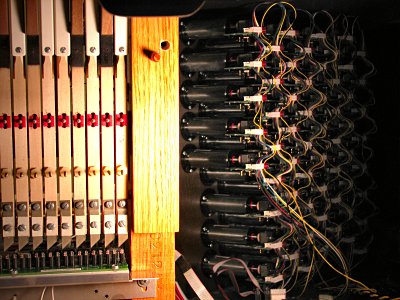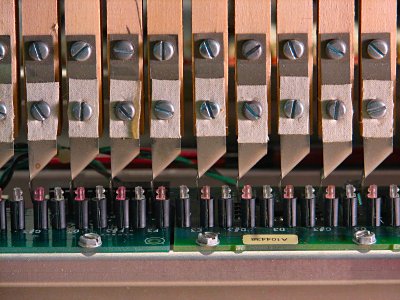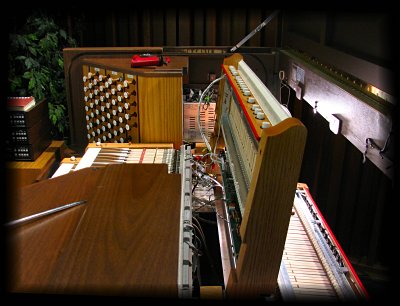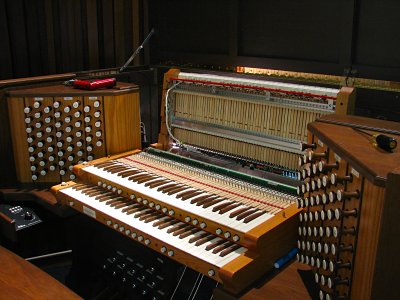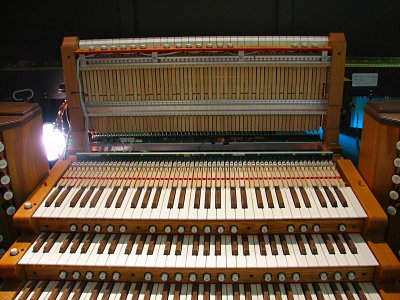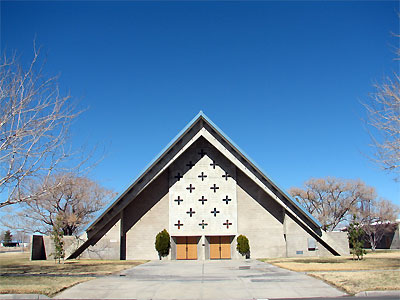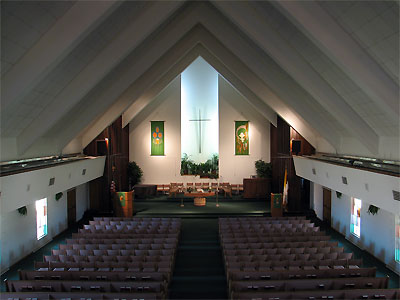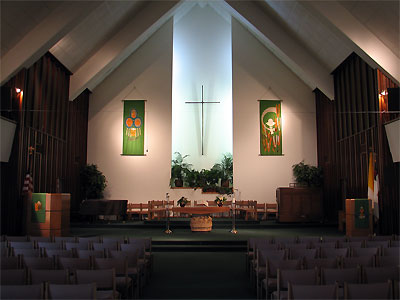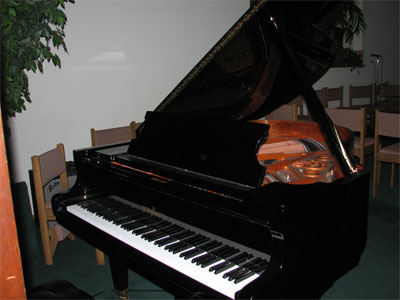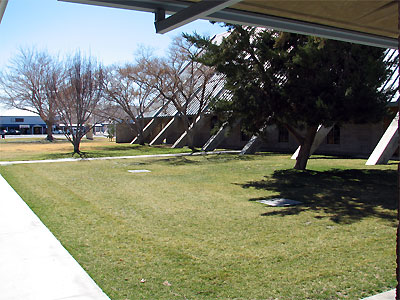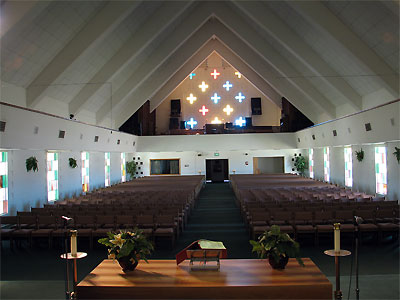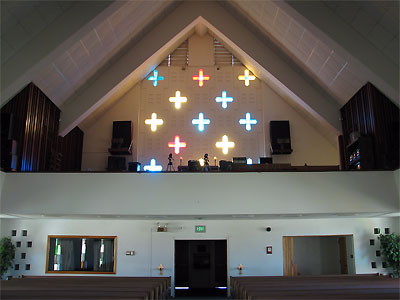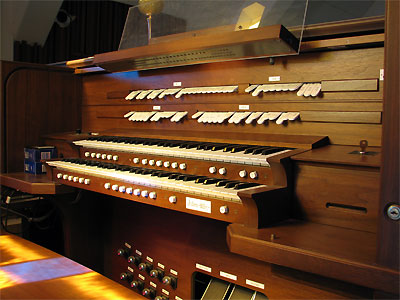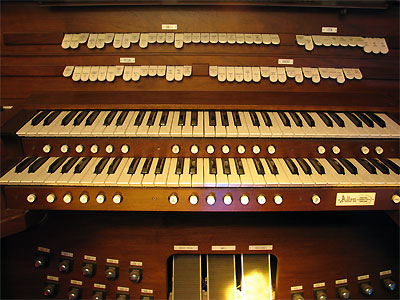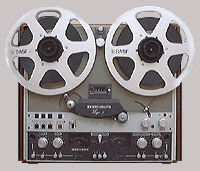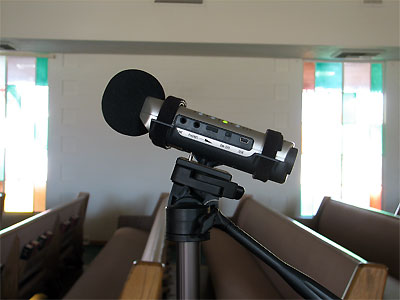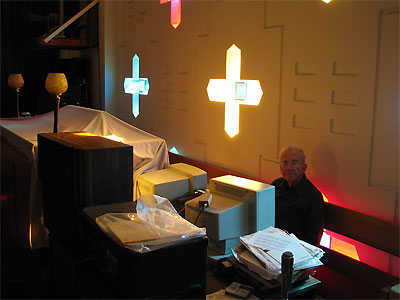
|
|
All Faith Chapel, NAWS China Lake
|
|
This month's featured organ is a Digital Church Organ manufactured by the Allen Organ Company and installed at the Navy's NAWS China Lake Facility in Ridgecrest, California. The base has a multi-denominational church known as the All Faith Chapel. The enormous organ is in the main sanctuary of this building, which can be seen in the picture below.
This custom instrument has 89 ranks. There are two external and one internal Allen MIDI Voice Expander modules that have more ranks which can be loaded as well. It has total MIDI capability and a swell shoe for each manual. There is a 64' Resultant in the Pedal division which also has four 32' stops. It has plenty of power and dozens of loudspeakers arranged in two chambers on either side of the front of the sanctuary. There is also an Antiphonal speaker system composed of two arrays along either side of a balcony in the back end of the sanctuary, giving the instrument four virtual chambers. The organ is lovingly maintained by Bob Leonard, a long standing member of the ATOS and a devout organ buff who also belongs to the American Guild of Organists. Bob was one of the main driving forces in getting this wonderful machine installed at the All Faith Chapel, having years of close ties with the Allen Organ Company as well as NAWS. He also helps out with the local Ridgecrest Organ Club, being one of the club's founders. |
A Closer Look at the Console |
|
The console of this fine organ is custom made to order from exotic woods. It features a Moving Combination Action and multiple levels of memory. The house organist for the All Faith Chapel, Raymond Blume, had this to tell us about the 4/89 Mighty Allen Digital Church Organ. We quote him in blue text below: The organ has 89 stops, with the capability of adding more stops to a Division, selected from one of the three Voice Expander modules. Only one stop per Division can be attached through these MIDI modules. Of the three expanders, the two external units are currently in the process of being hooked up. The other expander is built into the console of the organ on a pullout below the manuals and is the only one speaking at theis time. Only 4 Divisions can be selected from the expander, so a judicious choice of Divisions gives the best results. There is a shared swell shoe for the Great/Pedal Divisions. There is another set of speakers located on either side of the cross in the front of the Chapel, so altogether, there are 4 locations of speakers. The balcony speakers are accessed from the Antiphonal tilt tablets, with the exception of the Choir, which is accessed from a drawknob. The Antiphonal speakers can be used alone or in tandem with the Main speakers, or Main speakers alone. What I find even more rewarding and useful are the four 32-foot Pedal stops, including a Contra Bombarde. The instrument is divided into six Divisions: Great, Choir, Swell, Solo, Pedal, and a Floating String Division. Couplers are more than adequate for an instrument of this size. The Great/Pedal, Choir, and Solo Divisions can be used in an unexpressed state. There is the capability, with a tilt tablet, to change the "tuning" of the instrument, as well as one which can choose between a church type organ tremulant and a theatre type organ tremulant. There is a full set of toe studs. The left side studs duplicate 10 of the General Pistons, and the right side studs are devoted to controlling the Pedal stops and the manual to pedal reversibles, 32 foot reversibles, and the 2 different tuttis. The reversibles are duplicated with thumb pistons. There are a number of other controls for special uses. The organ has 16 programmable and lockable memories. The MIDI from the expanders work on a modulus technique, so that the expander settings programmed into, say Memory 1, will propagate to other pistons. I believe this is modulo 4, but I've forgotten that information. I've found this to be problematic when more than one person is programming memories, as another organist can change the registrations on any of the MIDI inputs from the expander, and it affects all the other inputs on that modulo. When we first got the organ, it was like having new rules for most everything (and we graduated from a 3-manual Allen Organ). Many facets of the instrument are not readily apparent, and I think, are learned only by experimenting and playing the instrument. I agree with your description of it as being a Mighty Allen, because it is just that. And to think, the new Allen Organs have made improvements to this instrument we have today. I enjoy the theatre organ, but have spent the past 46-plus years playing in churches, so I never had the time to develop any theatre organ techniques. Perhaps you can give me some instruction. If I should become passable at it, I might even want to join the theatre organ group. In this picture, we are looking at the left stop jamb of the console which houses the Pedal, Swell, and Floating String Divisions. Note the two Allen Voice Expander Units and the Recording Computer. The original 89 rank disposition, equivalent to approximately 100 ranks, can be expanded further via these expanders. One might say there are 300 ranks available, although the same stops are available on each expander. One of the many unique features of this organ is a Floating String Division that can be coupled to any manual or the pedals. It can be coupled to any of the other divisions, but it does not propagate. For instance, if the Strings were coupled to the Swell, coupling the Swell to any of the other Division will not couple the Strings. If you want the strings to be available on several divisions at once, the Strings drawknob must be pulled on in each division. To the left of the console are three black boxes attached via MIDI. The top two are the external Allen Voice Expanders. Beneath the two expanders is an Allen Performance Recorder, which allows an organist to record what he/she is playing and then play it back, including all stop knob and expression pedal changes. Here, we are looking at the four manuals and the back rail containing the intradivisional couplers. Note the dozens of pistons below the manuals. The interdivisional couplers are on drawknobs in each division. Finally, we swing around to the right stop jamb of the console which houses the Great, Choir, and Solo Divisions. The third voice expander is built into the organ and its controls are housed in a drawer under the stop jamb. Raymond had this to add about this fabulous instrument. We quote him in blue text below: There are some other things that are interesting about the instrument. The Swell, Great, and Pedal Divisions have second voices on some of the drawknobs. These are controlled by another drawknob in the affected division. On the Swell, it is the English Swell. On the Great/Pedal, it is labled Second Voices, which affects both the Great and the Pedal divisions. There is a Zimbelstern, operated only by a toe stud on the right side above the General Toe Studs. There is a Choir Unison Off coupler that didn't immediately seem useful, but there are certain registrations which can take advantage of this. For instance, if one wanted to couple Choir stops to the Great, such as Flute 8', Viole 8', Flute 4' and Octave 2', but wanted to use the expander to provide a Clarinet alone on the Choir. The Unison Off would suppress the Choir setting, but still couple it to the Great. The expander would provide the Clarinet, which isn't affected by the Choir's Unison Off coupler. |
Inside the Console |
|
In the photo above, we see the console from the rear with the covers removed to revieal the inside of the beast. The top lid has been raised and you can see the four manuals. Below these starting at the left we find several PCB's containing light driver matrix circuits for the varios status LED's and the swell indicators. In the middle are more matrix circuits for the controls. To the right is the cage that contains the computer and sample cards along with the power amplifier drivers. Along the bottom of the console are the power supplies for the various modules mentioned. In this shot, we move closer inside the console to get a better look at the matrix PCB's above the large cage where the swell shoes live, and you can see the organ computer cage off to the right and the power supplies below.
Here, we get a view looking straight into the heart of the organ. You can plainly see the stop jambs flanking the manuals above and all the PCB's, the computer cage, and power supplies. In the middle of the interior below the matrix PCB's is the black perforated sheet metal cage for the swell shoes. If you look closely at the computer cage, you will note it has a series of eleven vertically mounted modules inside. Starting on the left of these, we see the main computer module that controls the entire organ. Next, we see six units that hold all the pipe samples. Next are two units that send signals out to the power amplifiers and speakers. Finally, there are two blank modules that allow for future expansion.
Here, we move in still closer to get a good look at the matrix PCB's below the manuals. The top manual has been raised for servicing and you can see the contacts for the keys. This organ has manual keyers that require no cleaning because the contacts are electrical rather than mechanical.
Here, you can see the left end of the manuals and one of the two stop jambs that flank them. The organ has a moving combination action that is controlled by many pistons below the manuals and studs above the pedalboard on either side of the swell shoes. The stop knobs move in response to small electric solinoids, one for each knob.
Here, we get a very close view of the manual keyers. This system involves a metal spade that sits between two transisters for each key. These are known as Hall Effect transistors. One sends a signal that the other sees. As the key is depressed, the spade causes a change in the signal sent to the computer. The change in the signal has two values measured by the computer, one for key on and the other for how long it takes to press the key. Thus, the manuals are velocity sensative, with shorter key down times giving a faster time measurement.
As we move around to the right end of the console, we get a good wide view of the open top lid and the manuals which are raised for servicing. And that brings us to how and why these pictures were taken.
On September 22nd of 2008, the organ was serviced to rectify some problems that had been with it since being installed in the church. When the instruments was delivered, the wrong piston rails had been fitted under the two top manuals. As a result, the pistons would intermittedly stick in the pressed position.
Here, we look straight at the console from the player position, with the Solo manual still raised for servicing. The piston rails have been replaced and we are moments away from lowering the manauls and buttoning up the console prior to testing. After the instrument was closed, everything worked as advertised.
|
A Closer Look at the Chapel |
|
The All Faith Chapel caters to all religious beliefs, being conceived as a full service church for those who live on and around the NAWS base in Ridgecrest, California. We spoke with house organist Raymond Blume about the church and this is what he told us. We quote him in blue text below: The original name of the church, Our Lady of the Desert, was associated with the Catholic congregation of the time when the church was new. At present, there is only one resident congregation in the chapel and that is the Protestant congregation. The sanctuary of this beautiful church is large enough to seat over 800 people and has a balcony in the back. In the picture above, we are looking down form the balcony. In the view above, we see the Holy Dias in the front of the sanctuary where the console rests to the right and a fine Schimel German made Grand Piano is resting under a cover to the left of the platform. In the picture above, we see the beautiful Schimmel Grand Piano sitting on the left of the Holy Dias. When the lid is placed on a long stick, this fine piano has a wonderful tone that fills the sanctuary with a bright, clear voice which perfectly compliments the 4/89 Mighty Allen Digital Church Organ. The chapel is well maintained and the lawn is green around the expertly landscaped grounds surrounding the building, a rarity for this desert location. Note also the many trees that have been planted around the structure. |
The Smaller Balcony Organ |
|
Since this church is multi-denominational, there arose the need for a second organ in the balcony at the rear of the sanctuary in keeping with the Catholic tradition of the choir singing from this location, which they refer to as the choir loft. The balcony can be seen in the picture above as viewed from the Holy Dias. Organist Raymond Blume told us that this has not been the tradition of the chapel for many years, as he has played for the Catholic congregation. Whenever he played for the Catholic faith, he always used the main organ. Both the Protestant and Catholic congregations used the Holy Dias for the choir. Today, the Protestant handbell choir also uses the altar area for its performances. In the picture above, we see the Antiphonal loudspeakers for the 4/89 Mighty Allen Digital Church Organ, and other speakers and equipment for the second smaller organ which is also an Allen Digital Church Organ, but of older vintage known as a Digital Computer Organ. Here, we see the Allen Digital Computer Organ installed in the balcony. Ideally, this organ could be played via MIDI from the main console below. However, at the present time, it is not. This has been one of those things that may happen as the installation grows. In the view above, we are looking straight on at the keydesk of the Allen Digital Computer Organ. This instrument features a Moving Combination Action and stop tongue control of the ranks. It also has a Roland SoundCanvas connected via MIDI for orchestral arrangements, giving it an incredable amount of versatility in a small package. |
Free Music Downloads |
|
The Bone Doctor's RecordingsDoc's recordings are not traditional chapel organ arrangements. They are more akin to the kind of music one would hear from the Mighty WurliTzer Theatre Pipe Organ but played with a mountain gospel style. The first four selections below were recorded on the evening of February 20th, 2007. The next six were recorded on March the 3rd around noon.
|
About The Music |
|
On February the 20th during the evening, the Bone Doctor ventured out to the Chapel to have a go on the 4/89 Mighty Allen Digital Church Organ. This was at the request of Bob Leonard. Though unfamiliar with the instrument, Doc took the bench and noodled through some standard Gospel tunes, playing them in a very untraditional manner as though the huge organ was installed in a theatre rather than in a church. Most of the registrations were drawn from the General thumb pistons, though some hand regitering was done in the Pedal Division at the ends of the songs to bring on the tall boys for the ending stingers. In a couple of places, you will hear that unmistakable rumble of the mighty 64-footer.
About The Recording ProcessThe music we hear in the list of songs above was recorded live using a Samson Zoom H4 digital audio recorder, seen in the picture above. This machine is so small it can be mounted on a standard camera tripod. Able to run for four hours on a pair of AA batteries, it can record two hours of CD quality audio on a 1GB SanDisc sercure digital memory card the size of a postage stamp.
There are no moving parts and the recorder is completely self contained. Two electret condenser microphones are mounted in a coincident X-Y pair and protected by a windscreen. The electronics can model any mic, add compression, equalization, etc., via onscreen menus and a jog shuttle dial on the side of the case. A 1/8-inch stereo headphone jack allows monitoring of the signal going in as well as the playback during recording. To make the recordings, the Samson Zoom H4 digital audio recorder was mounted on the tripod and placed near the center of the congregational area about twelve rows back from the Holy Dias. It was tilted upward slightly so that the microphones were pointing at the cross. Headphones were used to monitor the quality of the incoming signal. After the recordings were completed, the recorder was taken to the Walnut Hill Office and connected via USB to the main data server so that the tracks could be offloaded to the hard drive file structure. Once the tranfer was completed, the tracks were edited in SoundForge6 to bring the levels up to -0.3dB using the Sonic Foundry Normalize and Waves L3 Multi-Maximizer DX Plug-ins. The heads and tails were cleaned and silence was added to the beginning of each track. After the tracks were edited, the Microsoft Plus! Audio Converter was used to convert the very clean and loud .WAV files into 128KB/sec .WMA files suitable for streaming broadcast over the internet. This method yealded some beautiful CD quality results for our listeners to enjoy. Look for more recordings done this way in the future as we explore the capabilities of this majestic installation and those in the surrounding area in the days ahead. |
About The Organ Technician |
|
The NAWS All Faith Chapel organ curator is Bob Leonard, who was responsible for installing the instrument. In the picture above, we see him hard at work in the balcony fine tuning the MIDI implimentation that will soon make it possible to play either of the two organs form both consoles. This is a work in progress which he is adding features to on a continuous basis. |
